[ad_1]
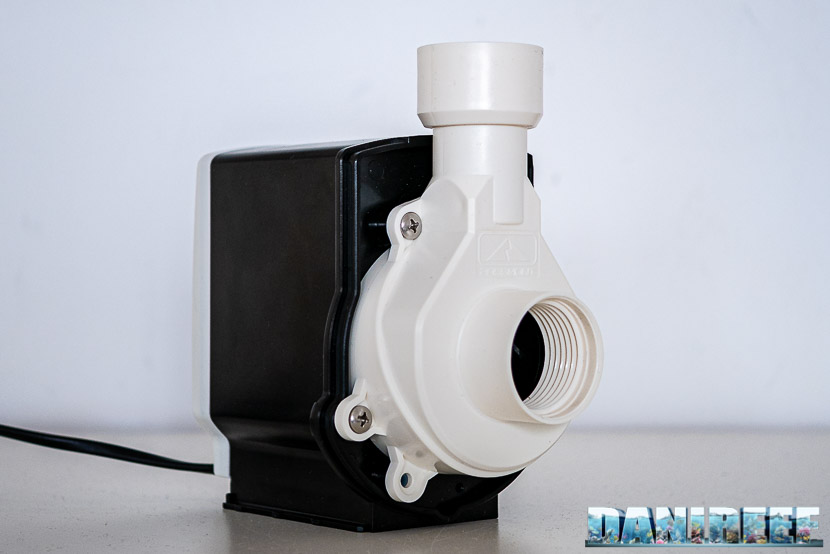 After the usual three months of tests here we are for the review of the Rossmont Riser RX 5000 return pump, which has a 5000 l/h flow rate.
After the usual three months of tests here we are for the review of the Rossmont Riser RX 5000 return pump, which has a 5000 l/h flow rate.
As we reported for its sister, the RX 3200 (review), the Rx 5000 is an alternating current pump, but it can be adjustable if matched with the Rossmont Waver (review).
We measured hydraulic head, flow rate, and consumption. We didn’t matched it with the Waver controller, so we only measured the maximum values. with this type of controller, there aren’t preset values for hydraulic head and flow rate, but it’s possible to adjust the pump to a couple of values for hydraulic head and flow rate, but we preferred to measure only the maximum.
For the hydraulic head we used the usual static method. For the flow rate we used the DigiFlow 6710M and for the consumption the RCE PM600.
| European Version 230 V – 50 Hz | American Verison 120 V – 60 Hz | |
| Flow rate: | 5.000 l/h | 1400 gph |
| Consumption: | 70 watt | 75 watt |
| Hydraulic head: | 3,6 metri | 8,5 ft |
| Length: | 14,2 cm | 5,6 in |
| Depth: | 10,2 cm | 4 in |
| Height: | 17,6 cm (solo corpo) | 7 in |
| Price: | 144,90 euro | 149,90 USD + VAT |
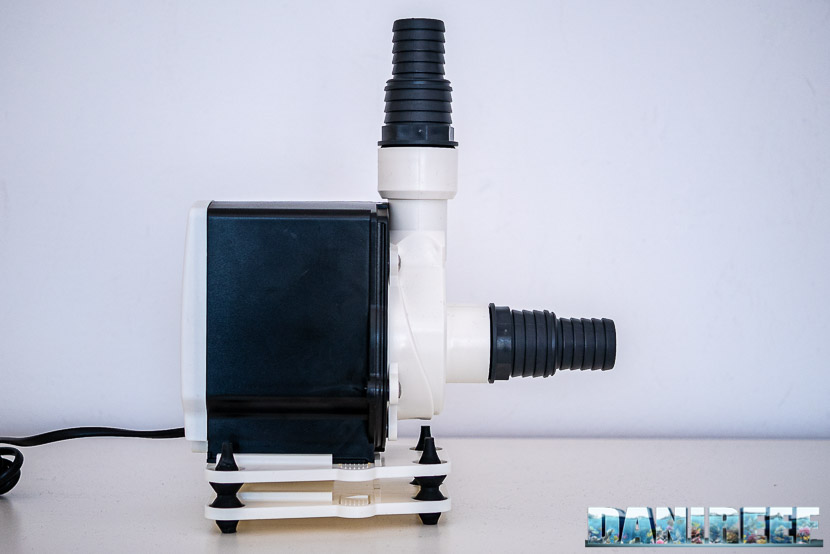
The Rossmont Riser RX 5000 has a declared energy efficiency of 71.4 liters for each watt and an economic efficiency of 345 liters per second per euro, so a value of 9.000 l*m/h.
So at a relative low price, at least for the promised performance, you can buy an excellent pump, to which you can add the Waver if you want to transform your AC pump into a very versatile controllable model. The economic efficiency is very good, as long as you don’t consider the Waver itself; including it gives you an average value. Let’s see now what we found in our lab, and how it compares to the value of the other pumps.
The construction
The pump has a simple design. Square. Black and white, which is Rossmont’s traditional style. 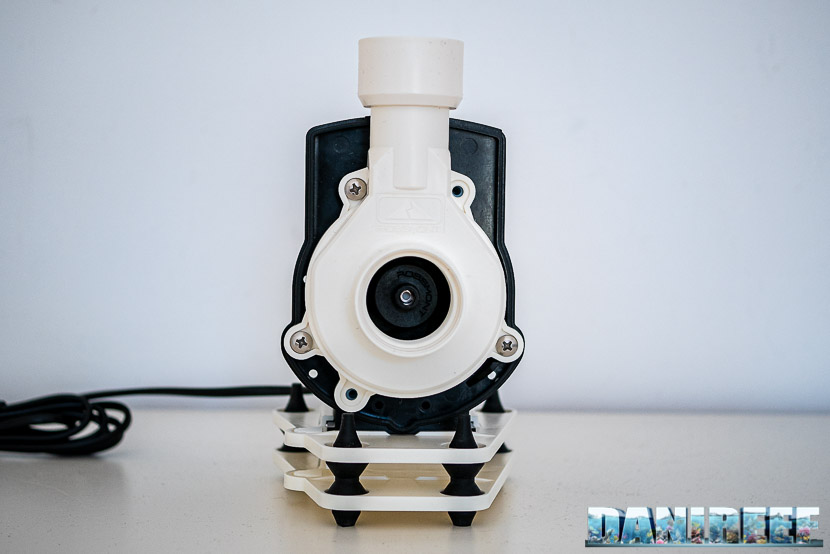
Inside the package we have the pump and a couple of hoses. The hoses can be sectioned depending on the diameter of your own return pipe. They’re 1.25 inches, which is is about 3,1 cm.
As usual we started by disassembling the shell of the impeller to see how it’s made. 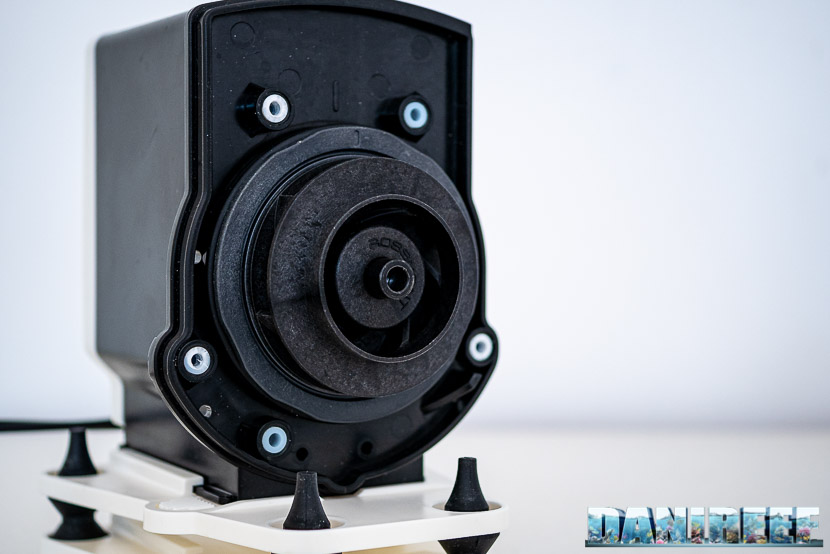
The impeller, for a flow rate like this, has curved paddles. It’s pretty small. 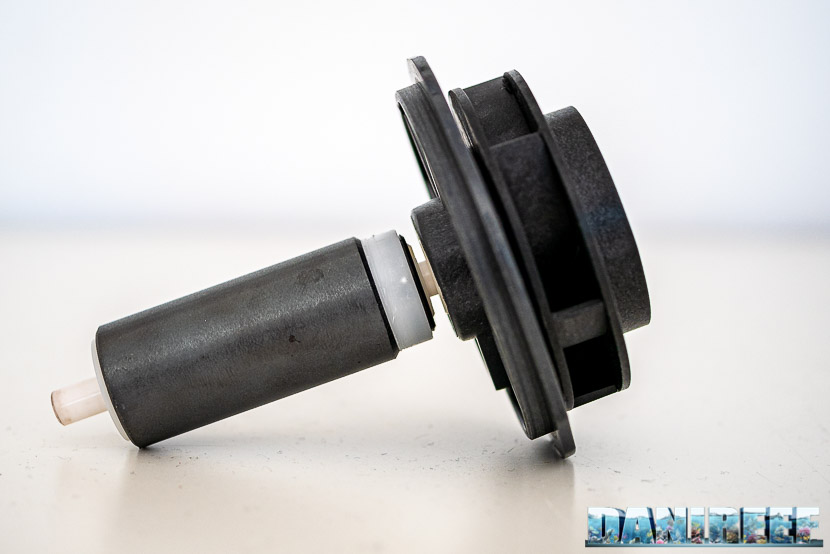
How to control the pump with the Waver
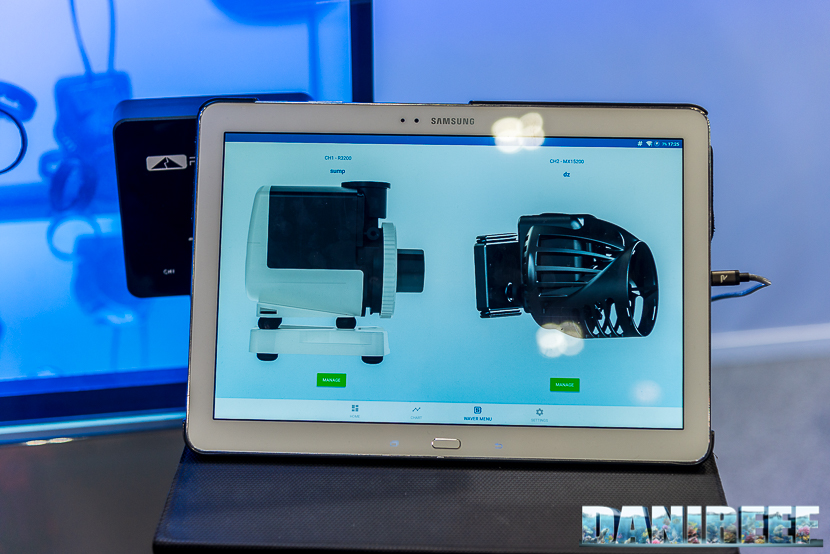
This paragraph is the same for the Riser RX 3200 since the modality of control is the same.
The main characteristic of this pump is that stand-alone is a common AC pump. But when it comes along with a Waver, the pump can be very versatile.
With the controller it’s possible to change the flow rate during the day; moreover, you can calibrate the pump. Through this modality you can choose the power so that the flow rate between sump and tank is zero. In this way you can feed your animals without any flow, while avoiding overfilling the sump with water. I really like this feature. It’s not anything new, but from what I know only Ecotech Marine implemented it on its Vectra.
You have to be careful because activating this function makes the level of water in aquarium decrease, but it’s absolutely normal. But feeding my corals at night, with my small pipe, with all the pumps switched off and without the sump filling up with water… is priceless.
Anyway, you can set your pump for every single moment of the day and night, without being restricted by fixed flow rates. You can choose what you prefer.
Hydraulic head test
The first test we did concerned the hydraulic head. As you may know the hydraulic head is the pump’s capacity to raise the water over a certain level. In order to do this test we measured the level of water reached inside the rubber tube. We didn’t measure every intermediate step as we usually do because in this case we didn’t have them.
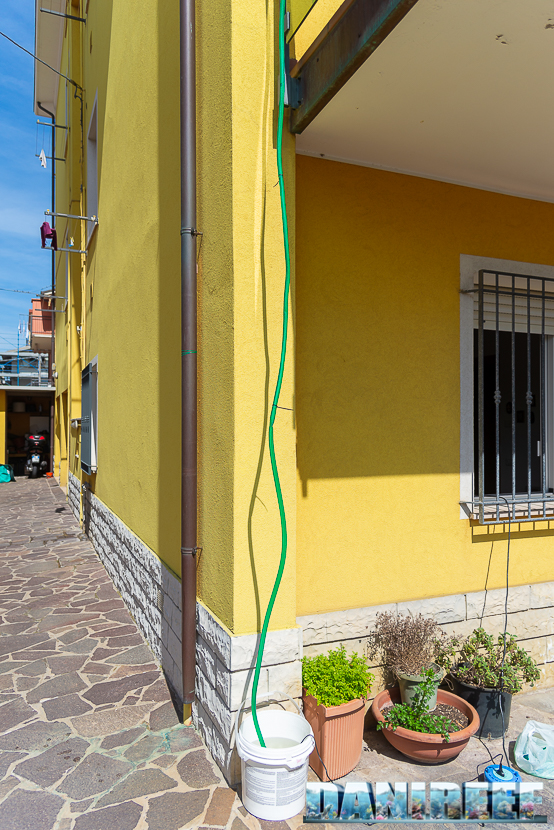
As you can see in the picture we fixed a pipe to the balcony. Then, we turned on the pump, we waited about 10 minutes for the pump to stabilize and then we did the measurement.
We measured a hydraulic head of 3.64 meters against the declared 3.6 meters.
The gap between the declared data and the one we measured is 1.1%, in favor of the pump. Perfect result.
Flow rate test
Testing the flow rate was an easy task thanks to the DigiSavant DIGIFLOW 6710M flow rate meter. The first thing we did was connect the tubes to our meter, as you can see from the picture below.
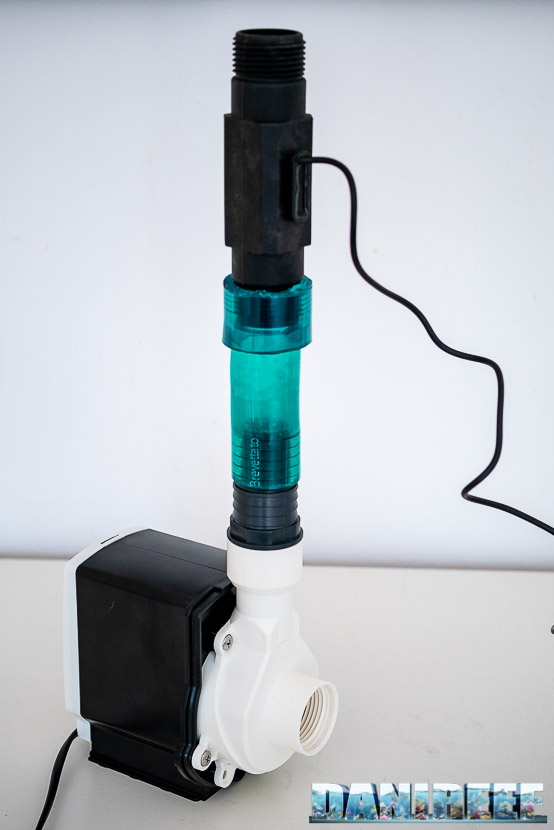
We tried to make the meter perfectly join the exit of the pump. 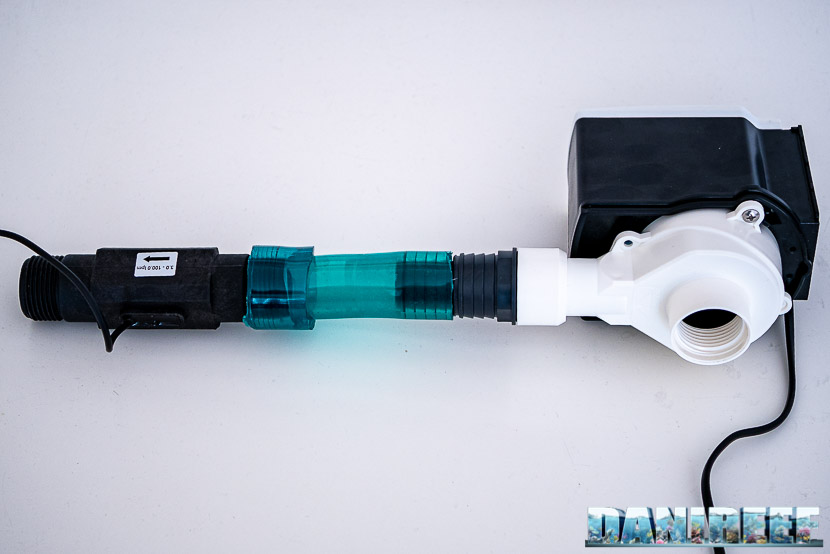
The measurement is expressed in liters/minute, so we just had to multiply the result by 60 to obtain liters per hour.
Remember that this measurement is valid for the conditions in which we did our tests. The connecting tube could have introduced some losses in the system.
This system gave us this value: 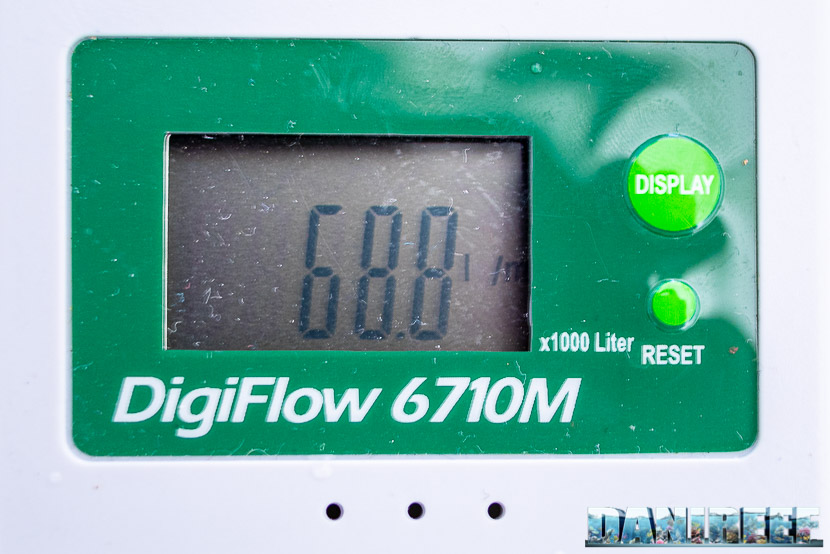
The maximum flow rate 4,128 l/h (that is 68.8 l/m*60), slightly under the declared 5,000 l/h. So the pump reached 83% of the declared value in the conditions of the test. A great result if we consider the 66% of the Ecotech Marine Vectra M1 (article), the 67% of the Waveline DC6000 (article), or the 70% of the Hydor Seltz D6000 (article), but slightly inferior to the 86% of the sister RX 3200 (article).
When you use a return pump be careful of things that may lower the flow rate, even drastically. Use the larger hose supplied. Use a sufficiently large tube. The tube should always be as short as possible and avoid 90° curves. Otherwise the flow rate will highly decrease.
Distinctive curve
The distinctive curve is that specific curve that links the various values of flow rate and hydraulic head. You can’t do this without the proper equipment. We linked the two ends of flow rate and hydraulic head, both the measured and the declared ones. 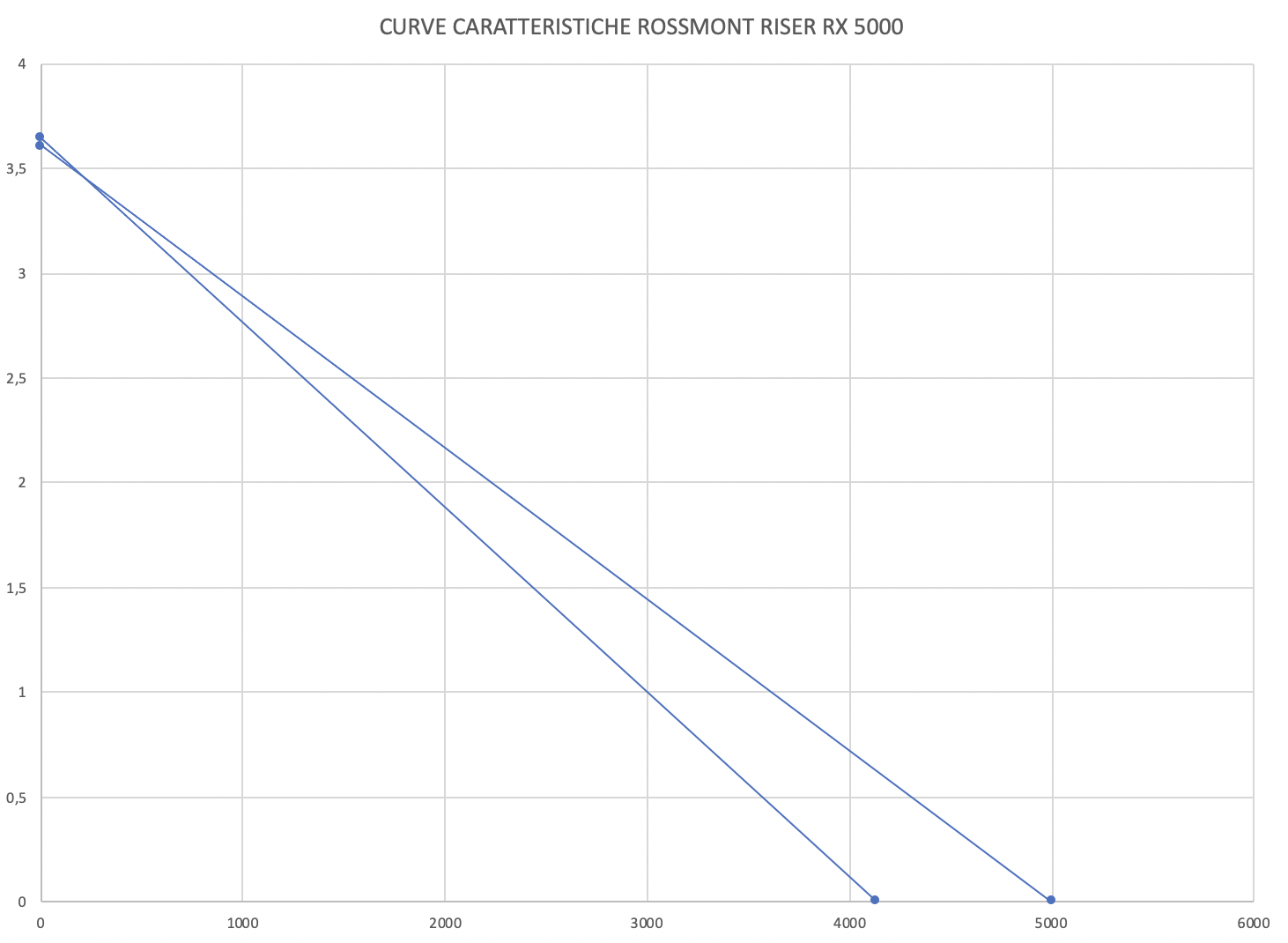
Now you can see how the difference between the declared value (the top curve) and the measurement is practically negligible.
In theory, if you put yourself at the hydraulic head value you need, for example 2 m, you should draw a line at the value of 2, see where this line crosses the distinctive line and read the corresponding flow rate value. With the Rossmont Riser RX 5000 at 2 m of hydraulic head you should have a flow rate of about 1,850 l/h against the declared 2,250. In aquarium the situation will be even worse because you have to add the friction of the tube and the curves.
In order to calculate the flow rate of your aquarium here’s a useful link with calculator integrated: automatic calculus of the return pump (italian).
Energy consumption test
The collection of data about the consumption has been made possible by the useful RCE PM600 that can also measure the Cos(fi) (or power factor). The result is directly given in watts. 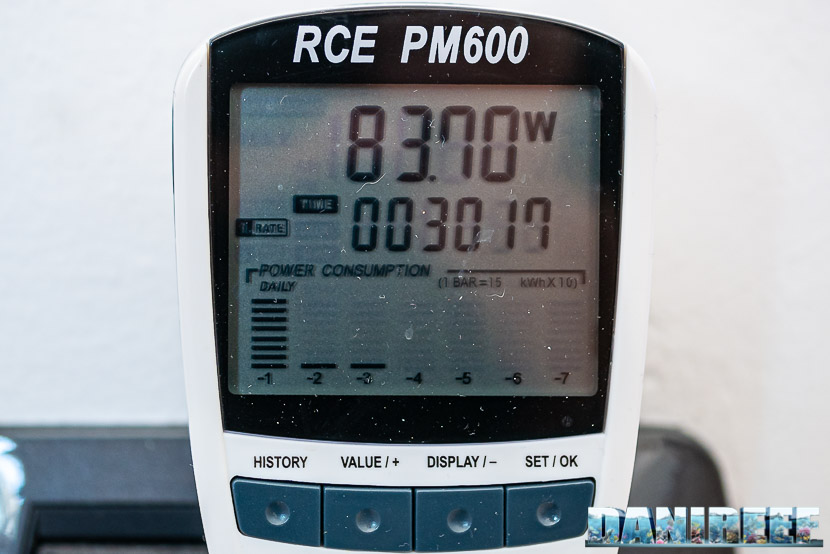
The maximum declared consumption of the Riser is 70 watts; according to our measurements the consumption is about 83.70 watts, almost 20% over the declared value. We need to take this difference into account.
Considering that the consumption is 83.70 watt, and the energy cost is 0,27 euro per kwh, we could use this pump continuously for a whole year, at its maximum, with a consumption of 470 kwh, and a relative cost of 198 euro per year, or 16,5 euro per month.
Given the dimensions of the pump and especially its flow rate level, we couldn’t do our noise test. We can affirm that the pump is very silent.
Our comments
An adjustable pump is the best thing you can have in sump, for a lot of reasons. The option to change the power to make it adapt to the conditions of the aquarium is the best. Thanks to the possibility of setting the pump, this you can change the water without switching off the return pump and this is a great comfort. Moreover, you can feed the corals eliminating any time of flow in aquarium. And you can activate this mode through your tablet or smartphone, or even through apple watch or similar devices. 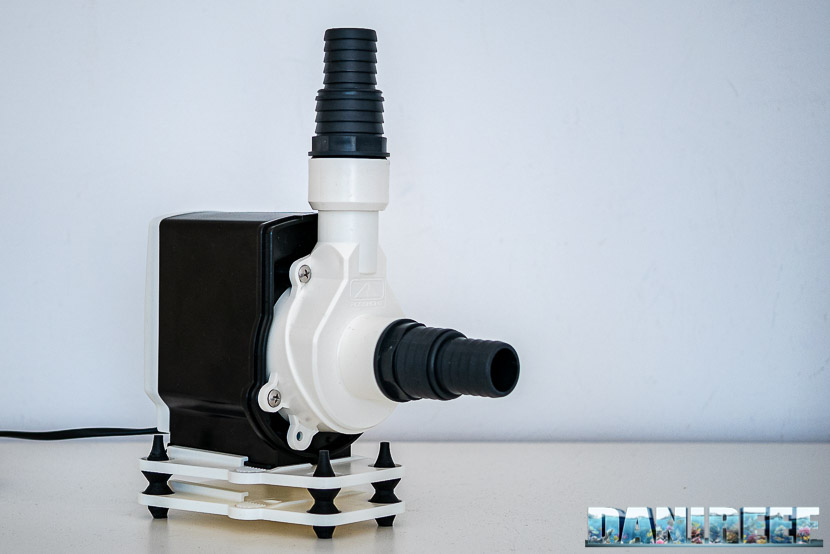
The conclusion is full of material, thanks to the comparison with other pumps we tested.
Comparison with other pumps
Comparison with other pumps leads us to very interesting conclusions. The other pumps we tested are Eheim, Hydor, Tunze, Sicce, Corallinea, Waveline, and Ecotech Marine, whose data are in the following chart. You can find all of them in our page of reviews . They’re ordered by the reference value of the pump, which is the product of the flow rate for the hydraulic head divided by two. In this way the area between the two sizes is obtained. We think this is the only way to compare similar pumps. If the reference value is very different, we believe that the pumps aren’t comparable.
| Pump | Hydraulic head | Flow rate | Reference value | Consumption | Price | Efficiency | Economic Efficiency | Annual Cost |
| Eheim 1250 | 195 cm | 1205 l/h | 1175 | 23.8 w | 98 € | 50.6 l/h*w | 12.3 l/h*€ | 56 € |
| Sicce Syncra 3 | 296 cm | 2375 l/h | 3515 | 42.3 w | 100 € | 56.1 l/h*w | 23.7 l/h*€ | 100 € |
| Rossmont Riser RX 3200 | 281 cm | 2766 l/h | 3886 | 53.7 w | 115 € | 51.5 l/h*w | 24 l/h*€ | 127 € |
| Eheim 1260 | 350 cm | 2434 l/h | 4260 | 62.1 w | 155 € | 32.2 l/h*w | 15.7 l/h*€ | 147 € |
| Tunze 1073.50 | 436 cm | 2143 l/h | 4672 | 38.8 w | 180 € | 55.2 l/h*w | 11.9 l/h*€ | 92 € |
| Sicce Syncra 4 | 380 cm | 3709 l/h | 7047 | 94 w | 160 € | 39.5 l/h*w | 23.2 l/h*€ | 222 € |
| Corallinea BQ5000 | 404 cm | 3504 l/h | 7078 | 83.2 w | 120 € | 42.1 l/h*w | 29.2 l/h*€ | 197 € |
| Rossmont Riser RX 5000 | 364 cm | 4128 l/h | 7513 | 83.7 w | 145 € | 49.3 l/h*w | 28.5 l/h*€ | 198 € |
| Waveline DC6000 | 392 cm | 4008 l/h | 7857 | 50.2 w | 283 € | 79.7 l/h*w | 14.1 l/h*€ | 119 € |
| Hydor Seltz D6000 | 450 cm | 4194 l/h | 9437 | 53 w | 125 € | 79.1 l/h*w | 33.5 l/h*€ | 125 € |
| Ecotech Marine Vectra M1 | 610 cm | 4944 l/h | 15080 | 89.5 w | 399 € | 55.1 l/h*w | 12.3 l/h*€ | 212 € |
In the chart is also the last six variable flow pumps, the Tunze 1073.50, the Corallinea BQ5000, the Waveline DC6000, the Vectra M1, the Rossmont Riser 3200, and the Hydor Seltz D6000.
Looking at the chart you can see that, from an economic point of view, or the flow rate per euro, the RX 5000 is one of the most convenient pumps with its 28.5 l/h per euro. Technically speaking, the Waveline DC6000 wins by an inch over the Hydor Seltz D6000, but this Riser is in third place. So, if the values you’re searching for match with this pump, as you can verify with our calculator, you’ve found what you need. Also, at any time you can adjust this pump with the Waver.
Relationship with the declared data
Now let’s see the relationship with the data declared from the builder.
Hydraulic head
| pump | hydraulic head | measurement | difference |
| Rossmont Riser RX 5000 | 360 cm | 364 cm | + 1.1 % |
The hydraulic head as we have measured has an insignificant difference. The Riser keeps its promises.
Flow rate
| pump | Flow rate | measurement | difference |
| Rossmont Riser RX 5000 | 5,000 l/h | 4,128 l/h | – 17.4 % |
The difference between measured and declared flow rate is slightly over 17%. A noticeable result considering the great difference seen with other pumps.
Energy consumption
| pump | consumption | measurement | difference |
| Rossmont Riser RX 5000 | 70 w | 83.7 w | + 19.6 % |
The consumption is about 20%. We have to consider it noteworthy, even if in practice the energy efficiency remains pretty high.
Closeness to the declared data
Finally, as a term of comparison, we can use a match value on the base of the declared data for flow rate, hydraulic head, and consumption.
| pump | hydraulic head | flow rate | consumption | Final value (absolute) |
| Rossmont Riser RX 5000 | 101.1 % | 82.6 % | 119.6% | 88 % |
Conclusions
The reference value of the Rossmont Riser RX 5000 at its maximum power is about 7,857 l*m/h, where the declared reference value is 9,000, there is a moderate loss of 13%. Remember that the reference value is the area between the values of flow rate and hydraulic head, exemplified by their maximums. So we’re going to do this operation: (flow rate x hydraulic head)/2.
The loss of the 13% is actually a good value given the fact that all its competitors do a lot worse.
At the beginning of the article, we mentioned “the power we missed”, and we want to confirm it. The little sister RX 3200 that we tested last year, even if it was a good pump, lacked the great power that aquariums larger than 300 liters ask for. With this pump the gap has been filled. It not only is perfect, but it also has a backup of power that can be used. Moreover, you can also use it jointly with the Waver and benefit from this additional feature.
We have to consider what the pump obtained, not what it meant to obtain. In fact we have to choose our pump wondering if what has been measured matches our needs, maybe being also a little cheaper. We have to consider that if you want to program the pump you have to add the cost of the Waver.
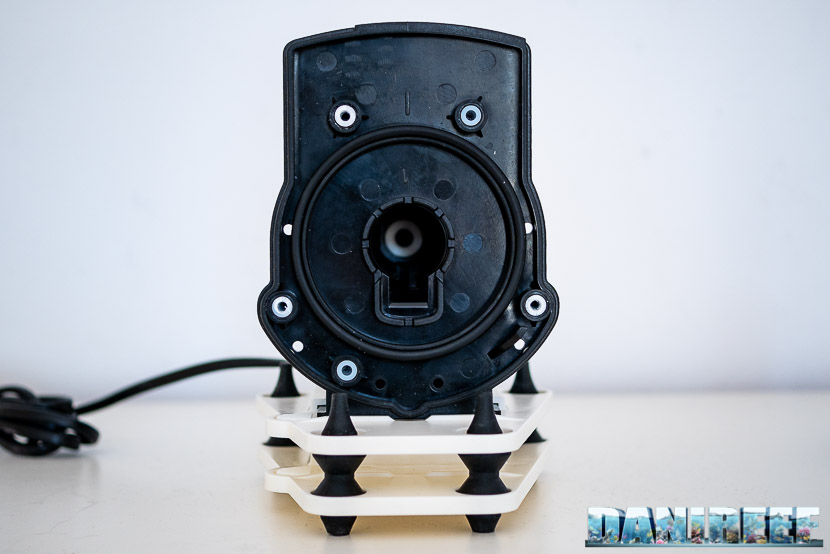
PROS
- Great performance and close to the declared data
- Adjustable pump on every value of flow rate among the available
- Very well built
- Very silent
- The calibration can stop the exchange of water between tank and sump
CONS
- High price with the optional Waver
- Consumption higher than declared
[ad_2]
Source link
